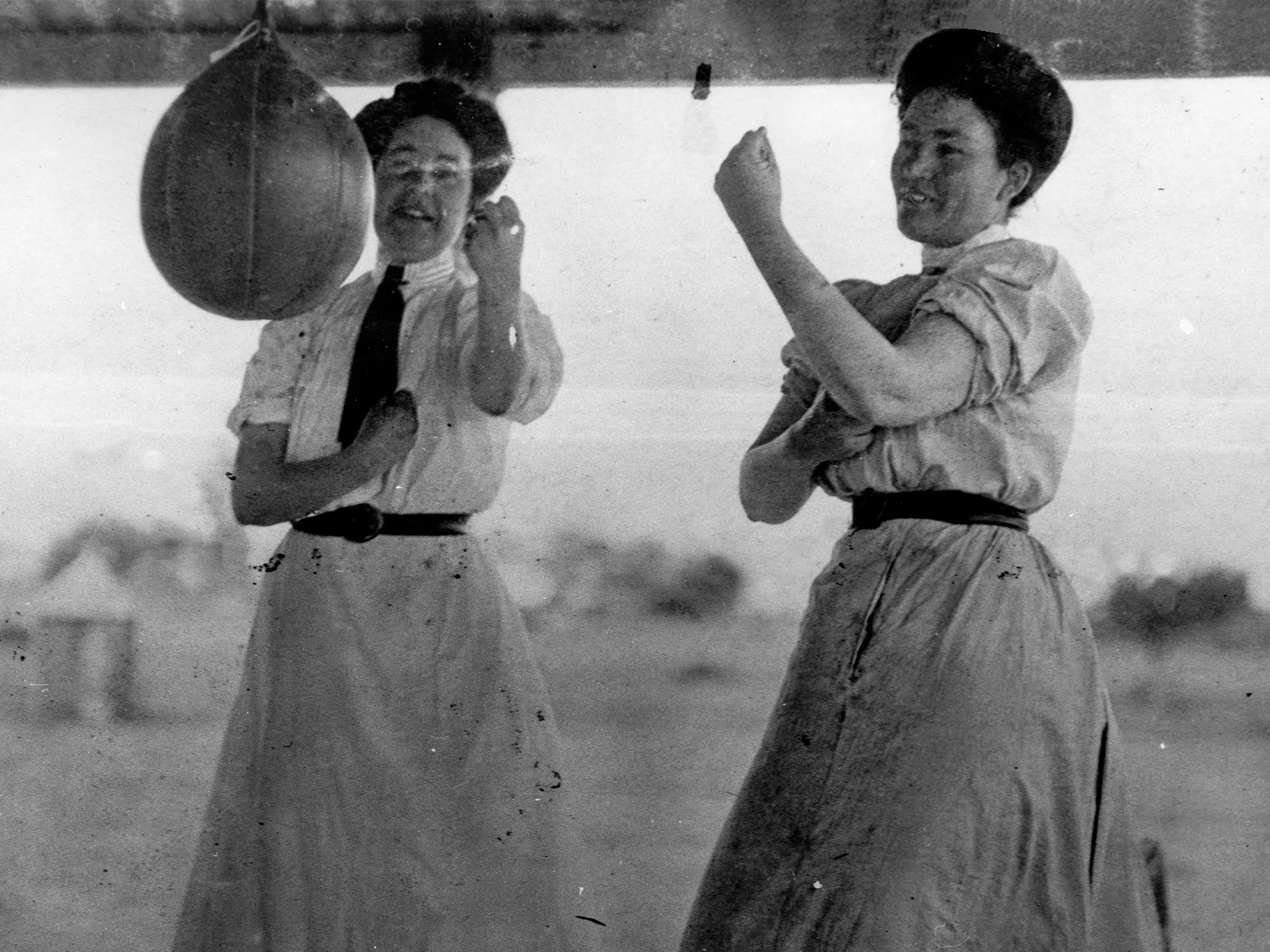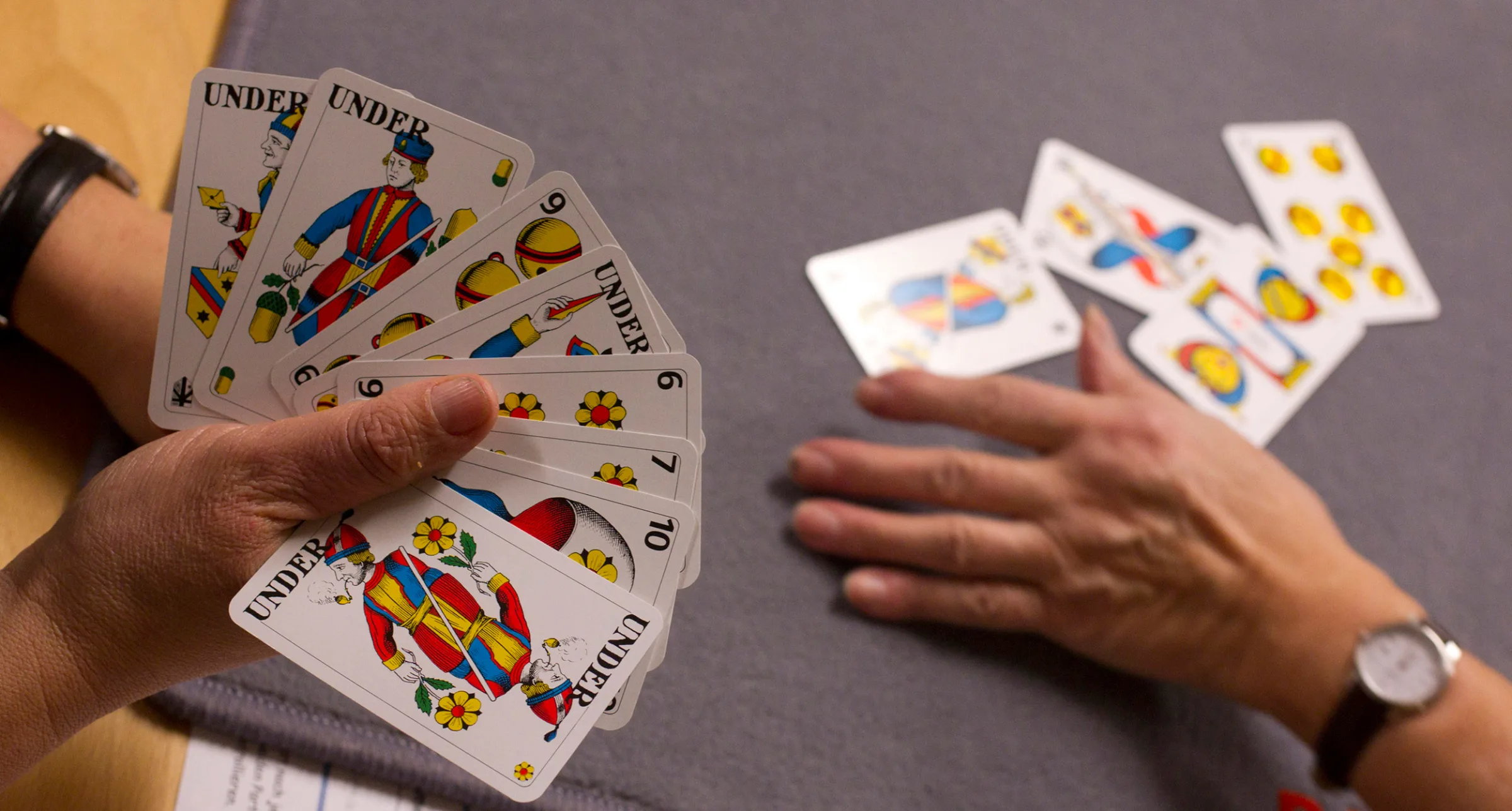
Before Jass
Swiss-German playing cards with the suits Schellen (Bells), Schilten (Shields), Eicheln (Acorns) and Rosen (Roses) have been around for more than half a millennium. Though they have only been used for the game Jass for the last 200 years or so.
The cheerfully striding out or dancing Schellenunter (Jack of Bells) with a jester’s cap, bell and jester’s rod on the fragment of a playing card printed in Basel around 1500 belongs to the earliest known version of this Swiss game with the four suits Schellen, Schilten, Eicheln and Rosen. The short-sleeved tunic and pointed shoes of the joker match the Late Gothic fashion. Despite its age, the figure printed from a wooden stick is immediately recognisable as a Schellenunter, even to us. The images on cards are conservative. They remain the same for centuries and outlive the games that are played with them.

Basel playing card. Schellenunter (Jack of Bells) with jester’s cap and donkey’s ears. Woodcut, stencil-coloured. Basel, around 1500. This card used by a bookbinder as filler was found in a book cover during restoration work. Photo: Swiss National Museum

Green glazed relief tiles with two female card players. The tiles were disposed of in the River Limmat when an old stove was demolished. Zurich, between 1400 and 1500. Photo: Swiss National Museum
Experienced players would have no problem playing Jass today using 500-year-old Basel cards. Though Jass in Switzerland is a much more recent game. Jas(s) is a Dutch word and game. Even the name of the Trumpfneun (Trump Nine), Nell, is borrowed from Dutch. The game Jass, played with 36 cards, was brought to Switzerland in the last third of the 18th century by Protestant mercenaries. “Jas” is akin to “farmer”. Tellingly, the first record of Jass being played in Switzerland is in Siblingen in Schaffhausen. Two farmers sued by Father Peyer at the Council, called Max Tanner and Sebastian Weber, confessed to having played “around a glass of wine” a game “which people call Jassen”. This was in 1796. The cards they were playing with at that time no longer came from Basel, but from Mümliswil in the canton of Solothurn. It was not long before Schaffhausen developed into a new centre of playing cards manufacture in Switzerland.
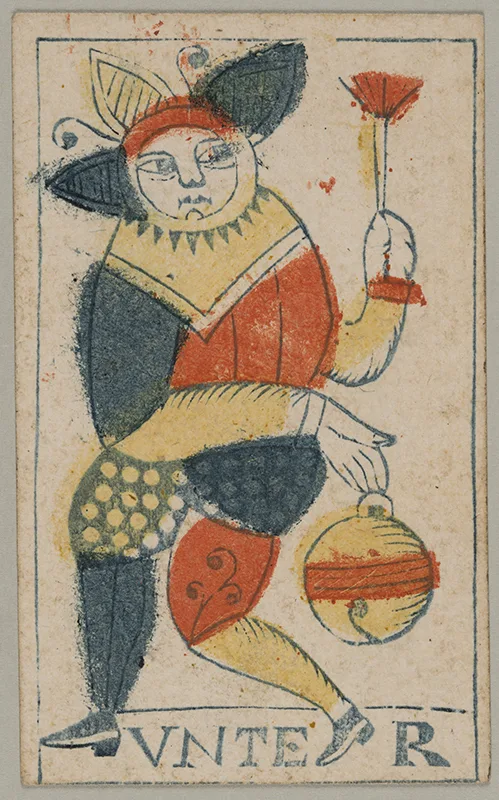
Solothurn playing card. Schellenunter (Jack of Bells). Solothurn, 1743. Woodcut, coloured. Printer: Rochus Schaer. Photo: Swiss National Museum
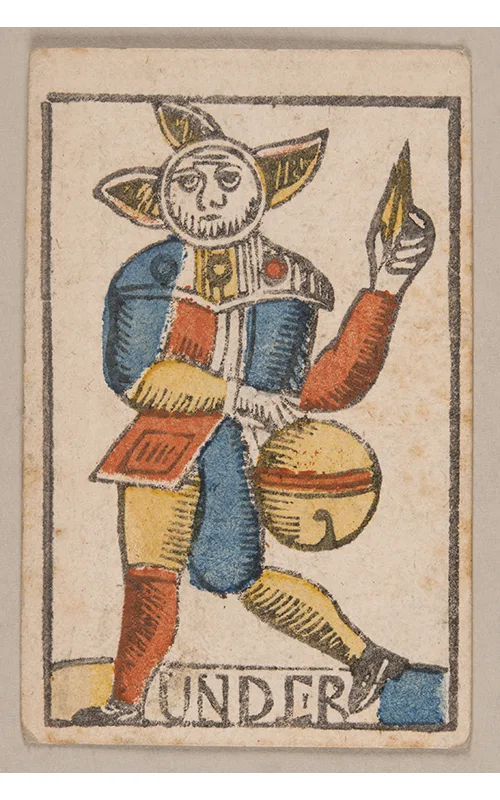
Schaffhausen playing card. Schellenunter (Jack of Bells). Schaffhausen, around 1800. Woodcut, stencil-coloured. Printer: David Hurter. Photo: Swiss National Museum
From marshal to joker
Let’s go back to the early days of the Swiss card game. We have no idea exactly how and when the third-ranking card after the König (King), namely the Unter or Bube (Jack), became a Bauer (Farmer) and the Schellenbauer (Farmer of Bells) became a Narr (Joker). The Dominican monk Johannes from Freiburg im Breisgau refers to the second-ranking card, the Ober, and the Unter as the two “marschalchi” in his playing cards allegory written in Basel in 1377. One of them holds the suit sign up, while the other holds it down. It comes as no surprise that in the Upper Rhine, and presumably in Basel itself, a centre of early printing of books and playing cards and of Late Medieval jester literature, the Schellenunter finally slips on a jester’s outfit complete with cap and donkey’s ears.
New cards from old clothes
Prior to industrial paper production, the cards were printed using wooden sticks on rag paper and then coloured with stencils. Any leftover pieces of fabric, even weathered scraps from scarecrows, were collected and processed in the paper mills to create paper. That is why practically no everyday clothes have been preserved from the time before 1800. Any no longer usable remnants of clothes worn by the people of Basel around 1500 were put to use in printing in Basel at that time to make books and playing cards. Perhaps the secret life of cards has something to do with this.
The shield with coat of arms as a suit
The Schilten (Shields) suit is unique to the Swiss game. This dates back to the time when the citizens emancipated from the nobility also gained coats of arms. The coats of arms on the shields of early Swiss cards can be seen as precursors to the likewise specifically Swiss stained glass windows depicting coats of arms and stained glass donations. The coat of arms of the Basel merchant Heinrich Halbisen, half a horseshoe, was used as the watermark in the paper produced in his paper mills and as a kind of trademark on the playing cards that he had printed. These are the oldest known playing cards from within the territory of modern-day Switzerland.
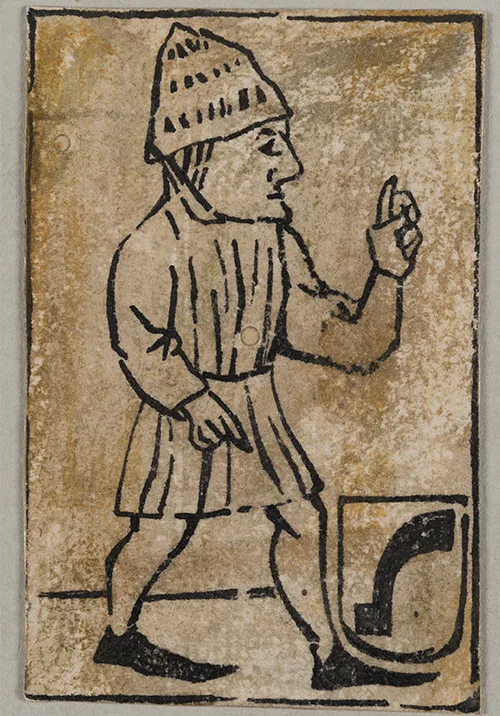
Basel playing card. Schiltenunter (Jack of Shields) with the Halbisen coat of arms. Basel, end of 15th century. Woodcut, uncoloured. Photo: Swiss National Museum
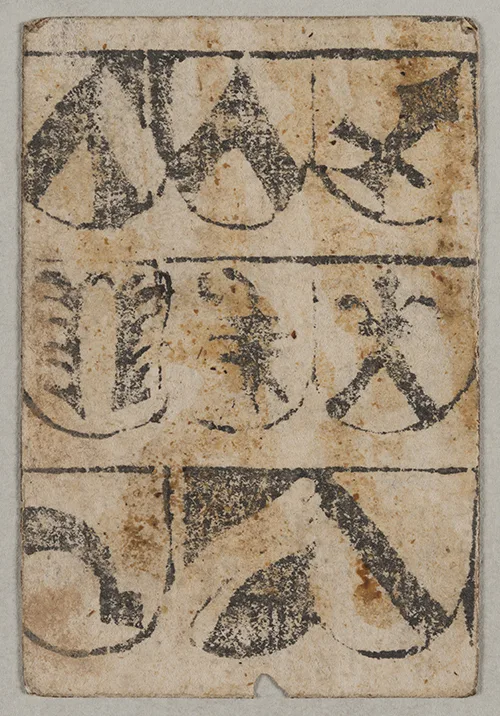
Basel playing card. Schiltenneun (Nine of Shields) with the Halbisen coat of arms at the bottom right and Basel rod in the middle. Basel, end of 15th century. Woodcut, uncoloured. Photo: Swiss National Museum
The farmer trumps the king
Probably the oldest and most widely played trump game is Kaiserspiel (Emperor’s Game) or “ludus imperatoris”. In the area of southern Germany there is documentary evidence of this game under the name of Karnöffelspiel as early as during the era of the Council of Basel, a time when in Basel the first cards were being printed with the precursors to the Swiss-German suits. The game still included the suits Hüte (Hats) and Federn (Feathers). These were replaced by Rosen (Roses) and Eicheln (Acorns) not long before 1500. These days, Kaiserspiel is only played in Central Switzerland. Kaiserspiel was the game of choice among Swiss mercenaries and mercenary foot soldiers in the northern Italian wars of the Late Middle Ages and the Early Modern period. It may be that this has something to do with why in Kaiserspiel, as a reversal of the courtly hierarchy, the “underpub” (Jack) could trump the “künnig” (King)?

Four cards from the Eicheln (Acorns) suit. Basel, around 1500. As a reversal of the courtly order, the Trumpfbauer (Trump Farmer) trumps the König (King) in Kaiserspiel (Emperor’s Game). Photo: Swiss National Museum
Il Tarocco
In the Early Modern period, Swiss and French mercenaries introduced another card game from northern Italy to their countries of origin. This game, which was popular in the Ancien Régime, was called “Il jogo degli trionfi” or “il tarocco”. Tarot is played with more cards than Kaiserspiel or Jass, and the cards are different. The 78 Tarot cards consist of 21 trumps or “tarocchi”, the Narr (Joker), and 14 cards in each of the Italian suits Cup, Coin, Sword and Baton. The Tarot game “Troggen” became widespread in Switzerland in the 18th century, especially in Solothurn, where famous Tarot cards were printed. In the 19th century, it was supplanted by Jass. These days, Troggen is still played in just two remote alpine areas: Visperterminen in Valais (“troggu”) and Surselva in Grisons, which is where Alois Carigiet came from (“dar troccas”).
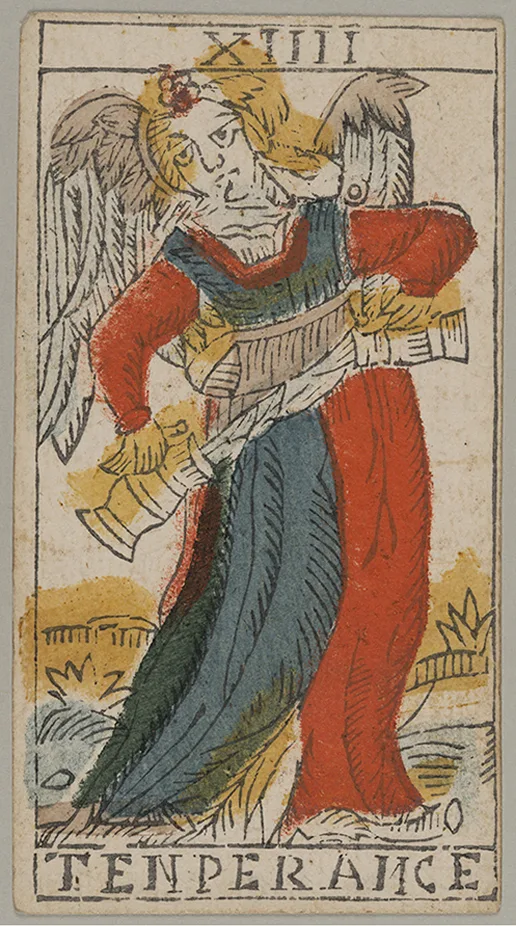
Solothurn Tarot card. Temperance (XIV). Mümliswil, around 1750. Woodcut, stencil-coloured. Printer: Franz Bernhard Schär. Photo: Swiss National Museum
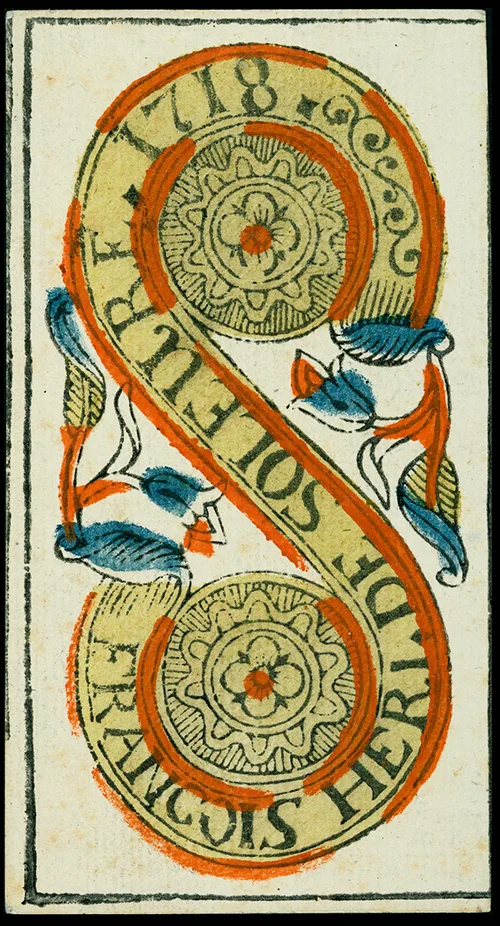
Solothurn Tarot card. Two of Coins. 1718. Woodcut, stencil-coloured. Printer: François Heri. Photo: Swiss National Museum
The jack of bells in advertising and art
Alois Carigiet, the illustrator of “A Bell for Ursli” and “Florina”, was a keen Tarot player in his youth. His love for this card game is reflected in his work as an advertising illustrator and artist. In 1938, he designed a pub poster for the brewery Brauerei Haldengut depicting the four Unter (Jack) figures from the Swiss-German cards dancing around a beer glass. In the foreground is the most striking of the four, the Schellenunter (Jack of Bells).

Alois Carigiet. Small poster for Haldengut beer. Colour lithograph. Zurich: Graphische Anstalt J. E. Wolfensberger, 1938. The pub poster mounted on cardboard and framed in the printing shop was both a wall decoration and a piece of advertising. Photo: Swiss National Museum
Unlucky at cards, lucky in love
In 1956, Carigiet painted a wonderful allegory of the card game on the façade of Hotel Adler on Rathausplatz in Stein am Rhein. He also worked the saying “Unlucky at cards, lucky in love” into the picture. In the middle of a game, the young Königin (Queen) draws the happily smiling Schellenunter (Jack of Bells) to her breast and strokes his cheek tenderly, while he demonstratively drops his left hand, revealing his pitiful cards. The ageing König (King), pictured to the right, casts a grim look down from his lion throne on those viewing the scene. In his left hand he is holding his cards – he has a very good hand – and in front of him is a bulging sack of money. But the young Joker has the better cards when it comes to the Queen. The ageing King’s anger about this is clear to see. It would appear that the reverse of the saying “Lucky at cards, unlucky in love” also holds true.
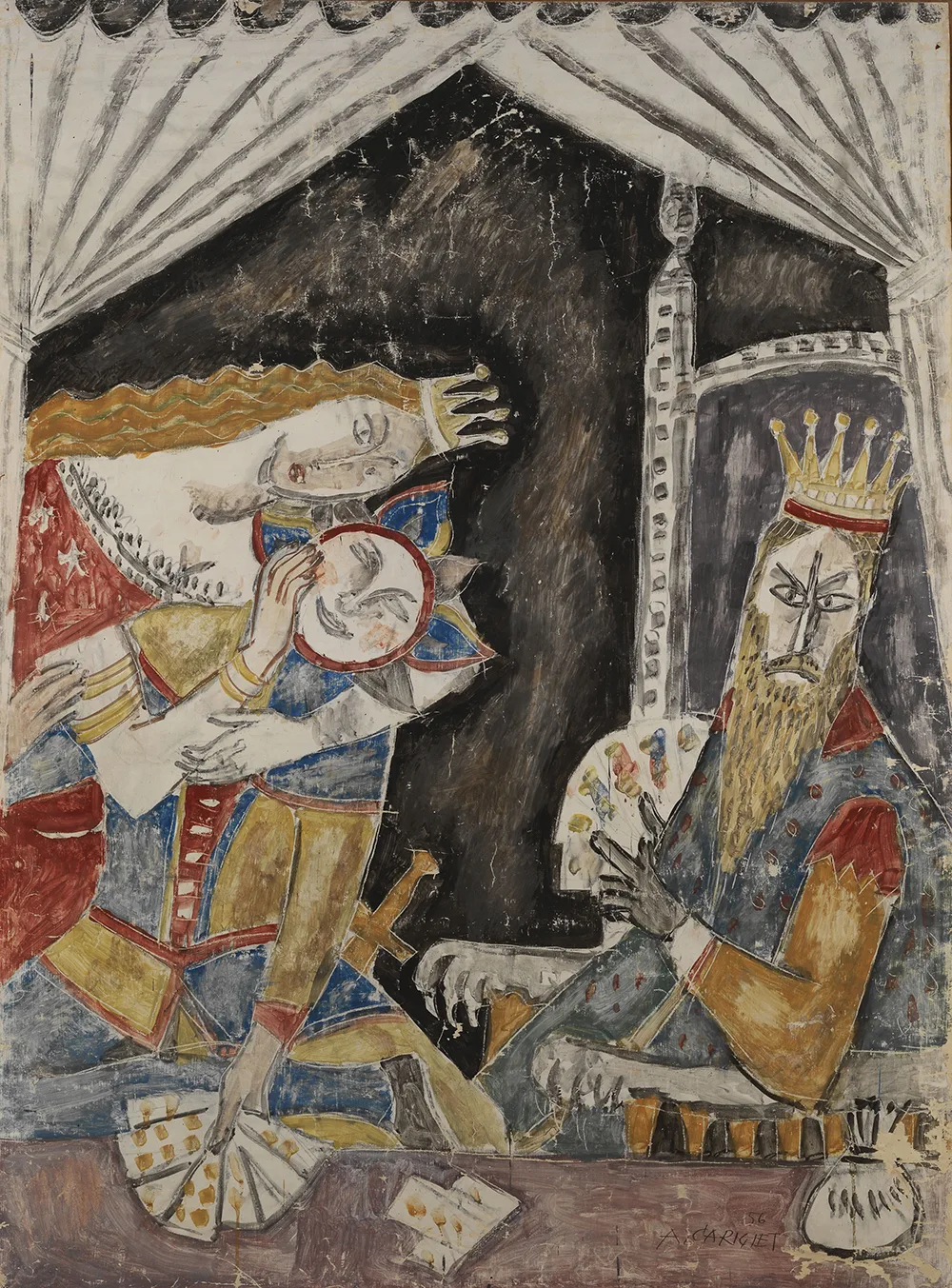
Alois Carigiet. Three personified playing cards. Original design for a mural on the façade of Hotel Restaurant Adler in Stein am Rhein. 1956. Gouache on paper. Privately owned. Copyright © Alois Carigiet Erben.
The figures of the King and Jack of Bells can be explained by Jass cards. But the fairytale Queen bending over the Joker with her horizontally flowing blonde hair cannot. There is no female figure in Swiss-German cards; there is in the French card game, but she is a Dame, not a Queen or Empress. This Queen has escaped from Carigiet’s native game of Tarot.


